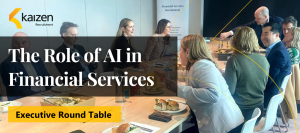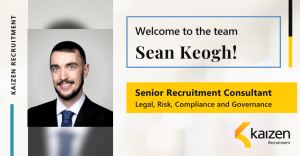AI in Financial Services: C-Suite Roundtable Insights | Kaizen
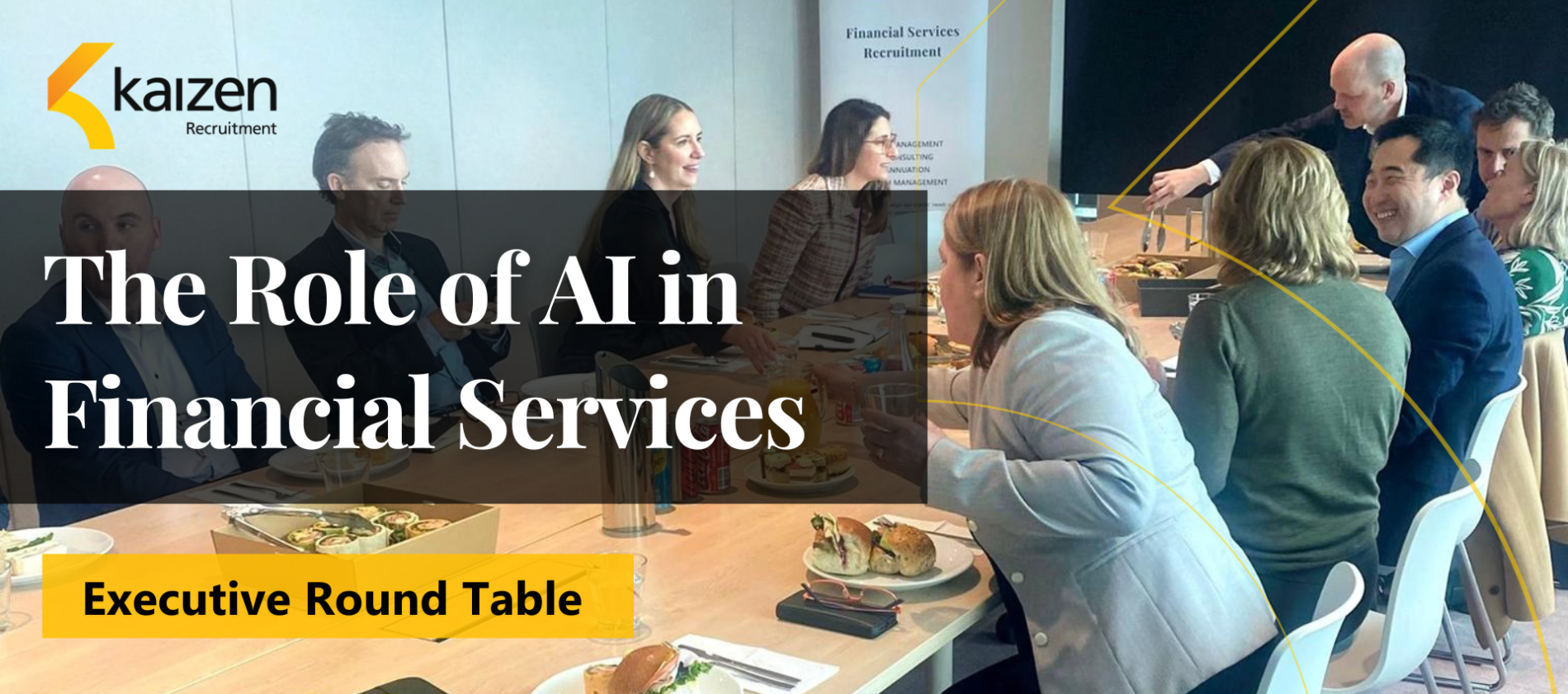 How will AI reshape the way financial services firms compete for market share, attract talent and deliver value to shareholders/members?
How will AI reshape the way financial services firms compete for market share, attract talent and deliver value to shareholders/members?
Kaizen Recruitment brought together several industry executive leaders in across Risk, Operations, Finance and Investments from Australia’s leading superannuation funds, asset managers, fintech, insurance and wealth firms across Melbourne and Sydney to host a series of Executive Roundtables. The agenda focused on the deployment and usage of AI within financial services.
A heartfelt thanks to Alice Tang and Will Liang, Co-CEOs of Amplify AI Group for their expert moderation and thought leadership, to IFM Investors and Aware Super for hosting these in their beautiful boardrooms, and to all C-Suite executives who contributed to these insightful and collaborative discussions.
Attending firms included:
Acorn Capital, AllianceBernstein, AQR Capital Management, Atlas Infrastructure, Bennelong Funds Management, Betashares, Channel Capital, Copia Investment Partners, Dimensional Fund Advisors, Ellerston Capital, ESSSuper, Future IM/Pact, Generation Life, Hearts & Minds Investments, IFM Investors, ISPT, Janus Henderson, La Trobe Financial, Magellan Group, Netwealth, Pacific Equity Partners, PIMCO, Platinum Asset Management, Raiz Invest, REST Super, Right Lane Consulting, RMBL, Russell Investments, Spaceship Super, StateCover, Team Super, UBS Securities, and VFMC.
How Executives are Investing in Individual Employees and Their Businesses
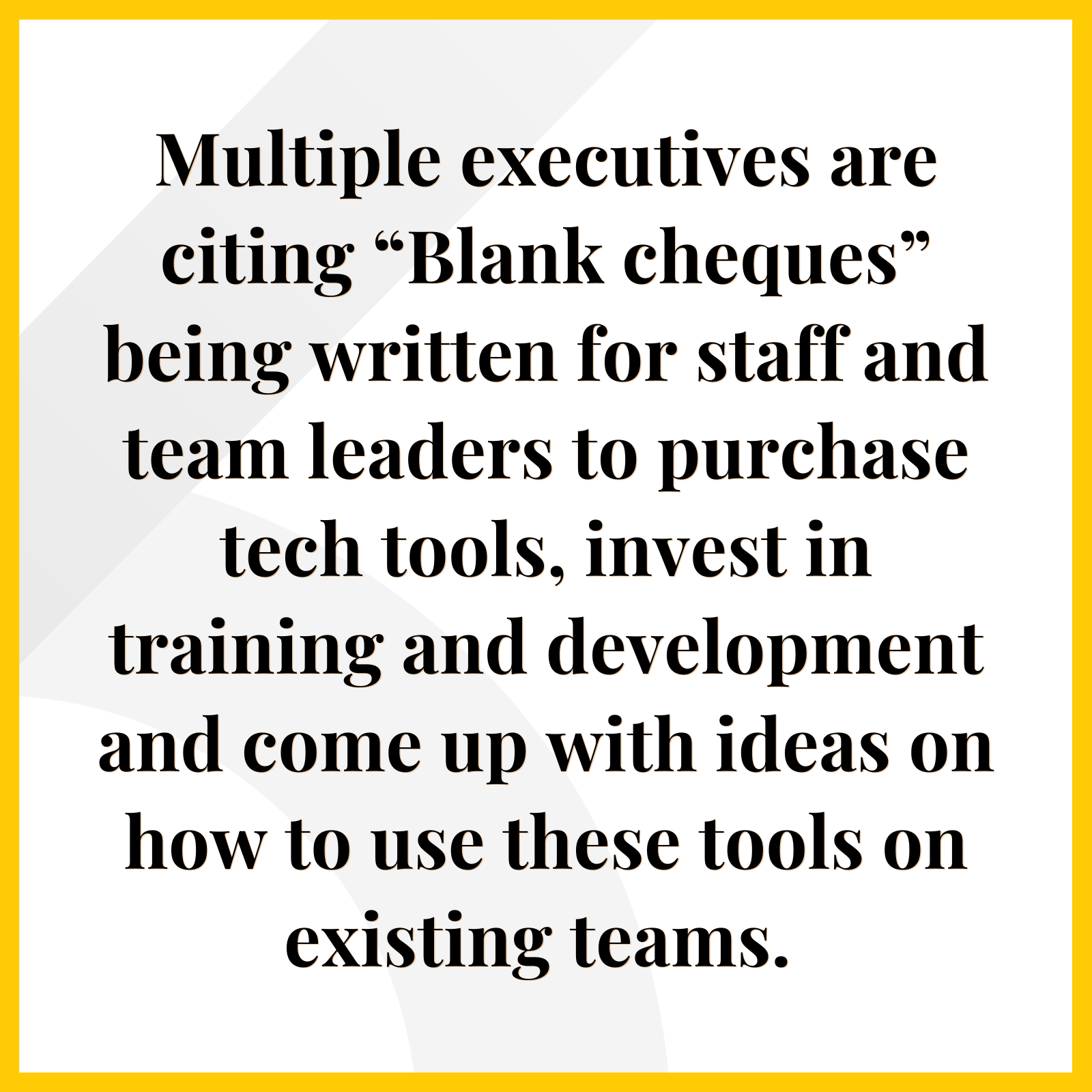 The sessions opened with executives reflecting on how dramatically technology has transformed their lives in the past decade, and particularly within the past year.
The sessions opened with executives reflecting on how dramatically technology has transformed their lives in the past decade, and particularly within the past year.
Firms discussed current strategies and use cases within their current organisations with multiple executives citing “Blank cheques” being written for staff and team leaders to purchase tech tools, invest in training and development and come up with ideas on how to use these tools on existing teams.
The goal being to uplift and innovate current work practices and foster healthy amounts of internal competition while finding ways to reward employees for notable progress and creative ideas.
Explore the topics covered in this article. Jump to any section by clicking the links below:
- The Three Major Challenges Holding Organisations Back
- Success Stories: Real-Organisational Impacts and Use Cases
- The Future of Workforce Planning
- Governance and Risk Management: A Strategic Shift
- Looking Ahead: Broader Societal Implications
The Three Stages of AI: A Framework for Understanding
Will Liang, outlined how AI adoption evolves through three distinct stages:
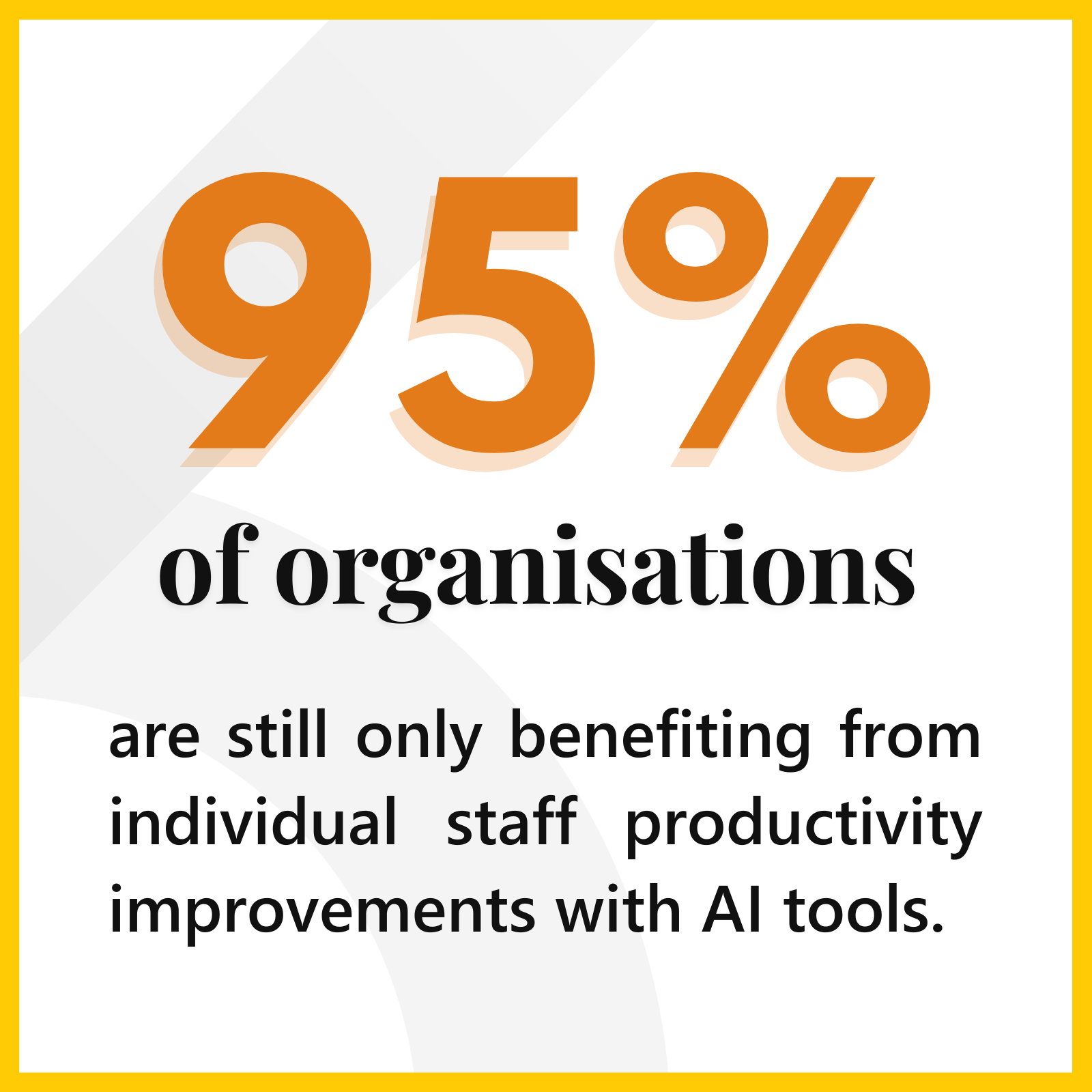
1. Individual Productivity – AI tools that enhance personal efficiency and output
2. Automation – AI systems that replace manual processes and workflows
3. Amplify – AI that multiplies capabilities and creates exponential value
A striking observation emerged across both roundtables: 95% of organisations are still only benefiting from individual staff productivity improvements with AI tools. Automation as a core business process is still not fully utilised, and very few have a cohesive AI strategy to seek competitive advantage. Enterprise-wide transformation remains rare, with most firms stuck in stage one.
The Three Major Challenges Holding Organisations Back

1. Technology Moving at Too Fast a Pace
The rapid evolution of AI technology makes it difficult for organisations to keep up and make strategic decisions with confidence. With new tech and AI solutions being released monthly and updates disrupting the status quo, organisations remain hesitant to fully invest in a particular solution for fear that new innovations will make current solutions obsolete.
2. Lack of AI Literacy
Organisations struggle with knowing what to use AI for and what not to use it for, leading to ineffective implementation. A recurring theme was “you don’t know what you don’t know,” underscoring the importance of hands-on training and prompt fluency to unlock real value.
Executives spoke of organisational cultures that were “risk-adverse” and therefore highly conservative with their approach and strategies vs “risk-aware” and trying to give an open invitation to staff to “play safely in closed ecosystems” to unlock productivity gains and foster innovation.
3. The Maturity of the Executive Team’s AI Literacy
Leadership teams often lack the technical understanding needed to guide AI strategy effectively. Many boards remain risk-averse and lack deep AI literacy, limiting the development of cohesive strategies to embed automation and unlock competitive advantage.
The role of the board in being a conduit for driving strategic change was discussed and the barriers that arise when board matrices are compromised by older demographics who are potentially less open to new technological solutions in favour of tried and tested strategies.
Success Stories: Real-Organisational Impacts and Use Cases
1. Staff Retention and Employee Satisfaction Transformed
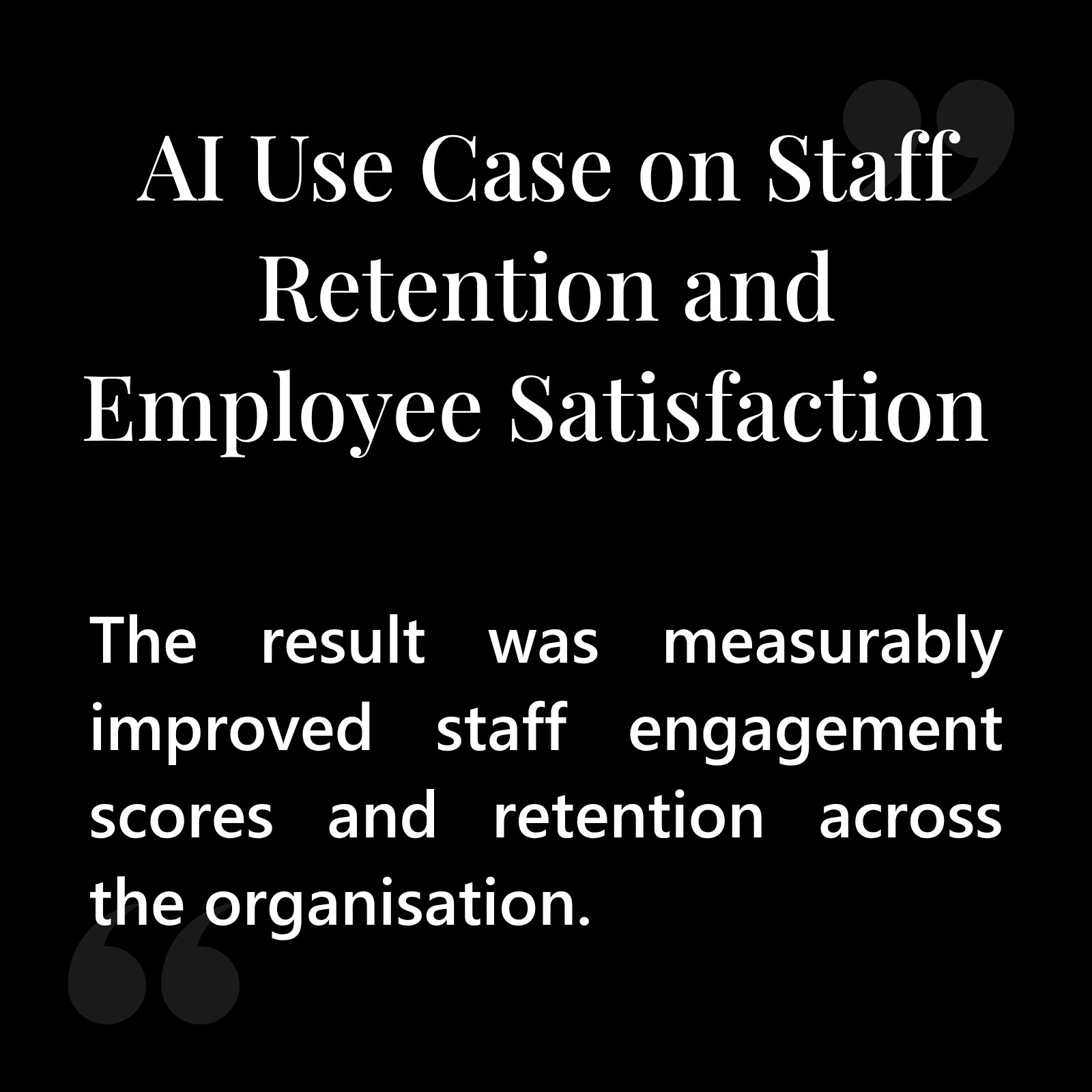 One executive provided a compelling example of how AI implementation dramatically improved staff retention. By using AI to remove boring, repetitive tasks from employees’ daily work, they freed up a couple of hours per Financial Adviser each day. This additional time was redirected towards client-facing activities, which staff members enjoyed significantly more.
One executive provided a compelling example of how AI implementation dramatically improved staff retention. By using AI to remove boring, repetitive tasks from employees’ daily work, they freed up a couple of hours per Financial Adviser each day. This additional time was redirected towards client-facing activities, which staff members enjoyed significantly more.
The technology also enabled AI to condense notes and provide coaching advice for the team, creating a more supportive work environment that helped leaders train their staff more comprehensively. The result was measurably improved staff engagement scores and retention across the organisation.
This case study underscores a critical insight: AI’s value isn’t just about cost savings, it’s about creating more meaningful work and improving the employee experience.
2. Increased Employee Productivity Raises Hard Questions for Leadership Teams
The roundtable extensively discussed strategic mapping of operational processes and how AI enables organisations to reduce hours while achieving higher outputs.
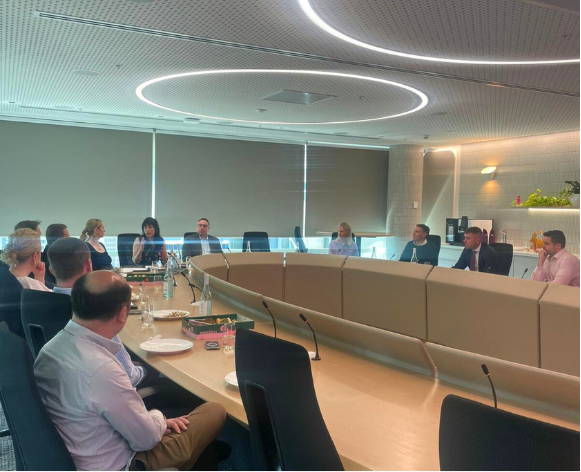 A particularly striking example came from a fund manager who shared that one individual on their team, through effective utilisation of AI and technology, now has the output equivalent of 1.5 to 2 full-time employees.
A particularly striking example came from a fund manager who shared that one individual on their team, through effective utilisation of AI and technology, now has the output equivalent of 1.5 to 2 full-time employees.
This example sparked an important question about compensation structures: Should employees who can effectively leverage AI and technology to achieve monumentally higher output be paid more than colleagues who don’t use these tools and therefore only have the output of one full-time employee?
This question remains unresolved but represents one of the most significant workforce challenges facing the industry.
3. Comprehensive AI Use Cases Across Financial Services
Participants shared numerous practical applications already delivering measurable value:
Investment and Research Applications
- Investment signals and decision-making: Using AI to analyse SEC documentation and public filings for stock picking and asset allocation decisions
- Due diligence transformation: Investment committee paper due diligence processes reduced by 80–90% through AI automation by one executive in attendance
- Research efficiency: Significant time savings on the investment research side by using AI to condense insights from Morningstar reports, Bloomberg data, and other market information
Client and Business Operations
- Investor relations and RFP processes: Building comprehensive product knowledge bases that can generate first drafts for investor Q&A processes and RFPs, often handling 600+ questions and creating massive time savings
- Legal and compliance: AI implementation for legal invoicing, analysing trends and elevating important information versus traditional manual review processes
These examples demonstrate that AI is already moving beyond experimentation into core operational workflows across multiple functions. Challenging considerations were unpacked around what the reduction of manual and historically laborious work often allocated to junior professionals means for training future team members.
In his book Outliers, Malcolm Gladwell introduces the “10,000-Hour Rule,” where mastering any skill requires approximately 10,000 hours of dedicated practice. This prompts a key question: How might this apply to developing deep subject matter expertise in the future, especially as AI increasingly automates tasks and reduces the time employees spend on them?
The Future of Workforce Planning

1. Cost Management vs. Human Capital
A critical question was posed to the group of executives: Do they foresee AI and technology as a mechanism to cost out headcount within their businesses to save money?
The overall response revealed a thoughtful and measured approach to workforce management:
- No terminations of present staff – Organisations are committed to maintaining current employees on teams.
- Maintaining current staff levels moving into the future – Existing teams remain intact as leaders plan for what new structures could look like.
- However, reduced future hiring volumes – Companies anticipate hiring fewer people in the same departments and roles going forward and multiple executives citied this is already playing out this past 6 months and into the year ahead.
- Different characteristics for future hires required – The profile and skills required for new workforce hires will be fundamentally different in particular roles, and many executives highlighted that new role types may need to be created, and responsibilities augmented in current individual roles on teams
2. The Evolving Nature of Work
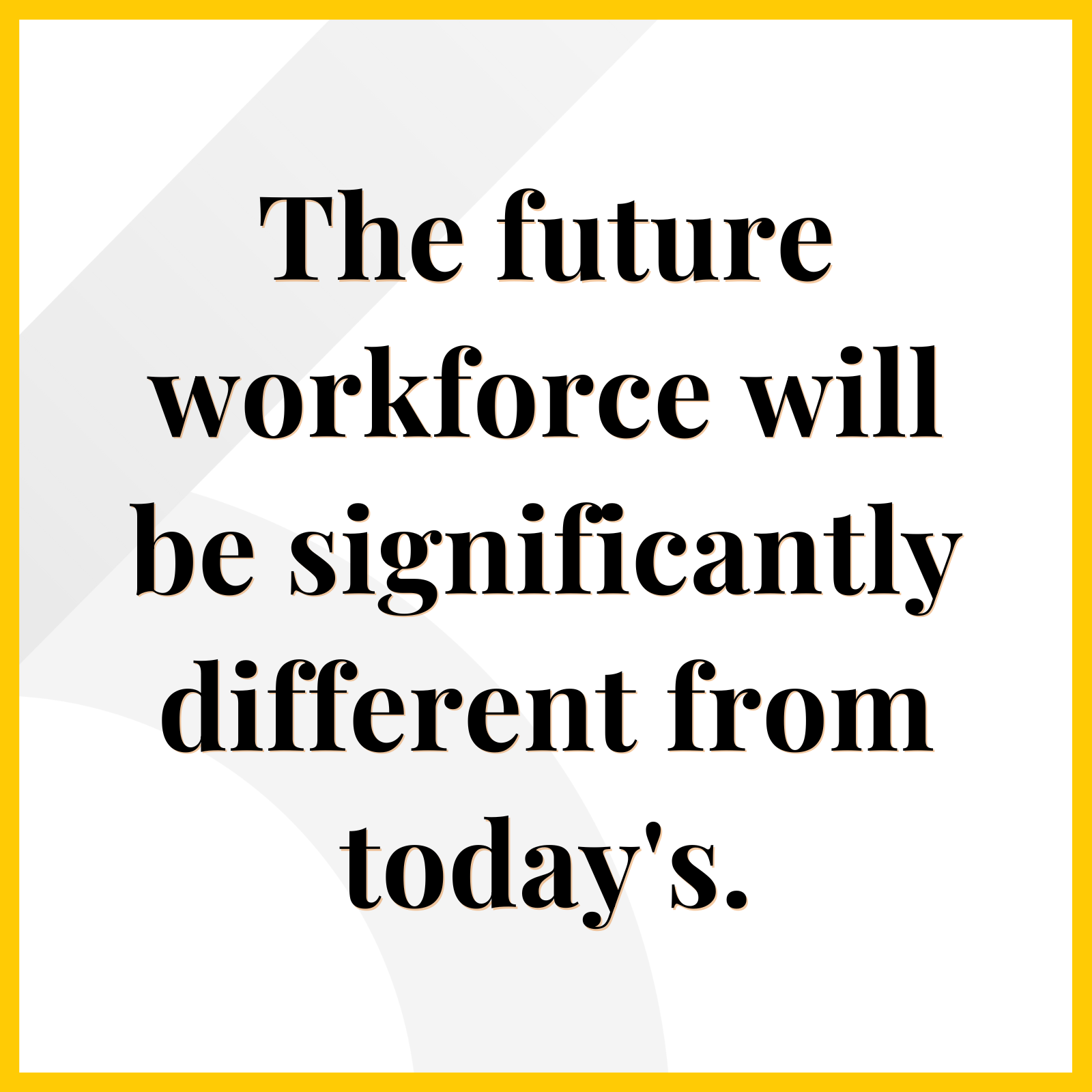
The discussion emphasised that the future workforce will be significantly different from today’s, requiring new skills, competencies, and approaches to work that integrate technological and AI capabilities. Several firms have already begun streamlining graduate recruitment pathways, citing efficiency gains from AI-driven automation. This trend raised difficult questions about long-term talent development and the erosion of traditional career ladders and pathways.
Organisations are planning to hire fewer people and drive greater output from existing staff, a fundamental shift in workforce strategy that will have profound implications for talent acquisition, development, and retention.
3. Rethinking Recruitment for the AI Era
One of the most compelling segments explored how AI is reshaping recruitment itself. Traditionally, candidates might be asked to complete an on-the-spot case study to test their analytical thinking and composure. One firm shared a new dual-case model designed to assess both problem-solving ability and AI fluency:
- Scenario 1: Candidates were given full access to AI tools and demonstrated gains in structuring their thinking, validating assumptions, and accelerating decision-making.
- Scenario 2: Candidates faced an in-person challenge with no digital assistance and a deliberately unpredictable curveball. This revealed a different skill set: resilience, improvisation, and the ability to navigate ambiguity with critical thinking.
The contrast highlighted the need for recruitment processes that reflect the realities of modern workflows, where AI is increasingly embedded in day-to-day operations, while still testing for uniquely human capabilities.
4. AI Usage Increasing Ability to “Cheat” to Land Roles
Multiple leaders cited virtual interviews being reduced in favour of in-person interviews as talent teams share stories of candidates using AI tools to promote answers to questions where the stakeholders in attendance noticed, and discounted candidates for “perceived cheating” when they would have looked more favourably on getting answers slightly wrong to hear a candidate’s genuine thought process/ opinions.
Governance and Risk Management: A Strategic Shift
From Risk-Averse to Risk-Aware
The governance discussion focused on how to implement appropriate guardrails for AI systems. A key theme was shifting organisational mindset from being risk-averse to being risk-aware, understanding and managing risks rather than avoiding AI adoption entirely.
Implementation Considerations
The roundtable emphasised the importance of thoughtful governance frameworks that enable innovation while maintaining appropriate oversight and control mechanisms. However, the tone was pragmatic: rather than debating whether AI would transform the industry, participants explored how to shape that transformation responsibly.
Ethics and Transparency
Ethics and transparency emerged as critical issues. Executives debated the risks of black-box AI systems and the need for clear accountability. Who drives transparency? Who bears the risk when decisions go wrong? There was consensus that ethical frameworks must be embedded from the outset, not retrofitted after deployment. Yet the mechanisms for doing so remain elusive.
The Security Paradox- Reverting to Offline Manual Processes to Protect IP
As AI threats become more sophisticated, some firms are responding by reintroducing manual processes and stricter controls. Voice authentication, multi-factor verification, and human overrides are no longer seen as temporary safeguards, they’re deliberate countermeasures against the criminal misuse of AI.
While these measures enhance security, they also risk slowing down workflows and undermining the efficiencies AI was meant to deliver. The challenge lies in finding the right balance between protection and progress.
The Critical Thinking Challenge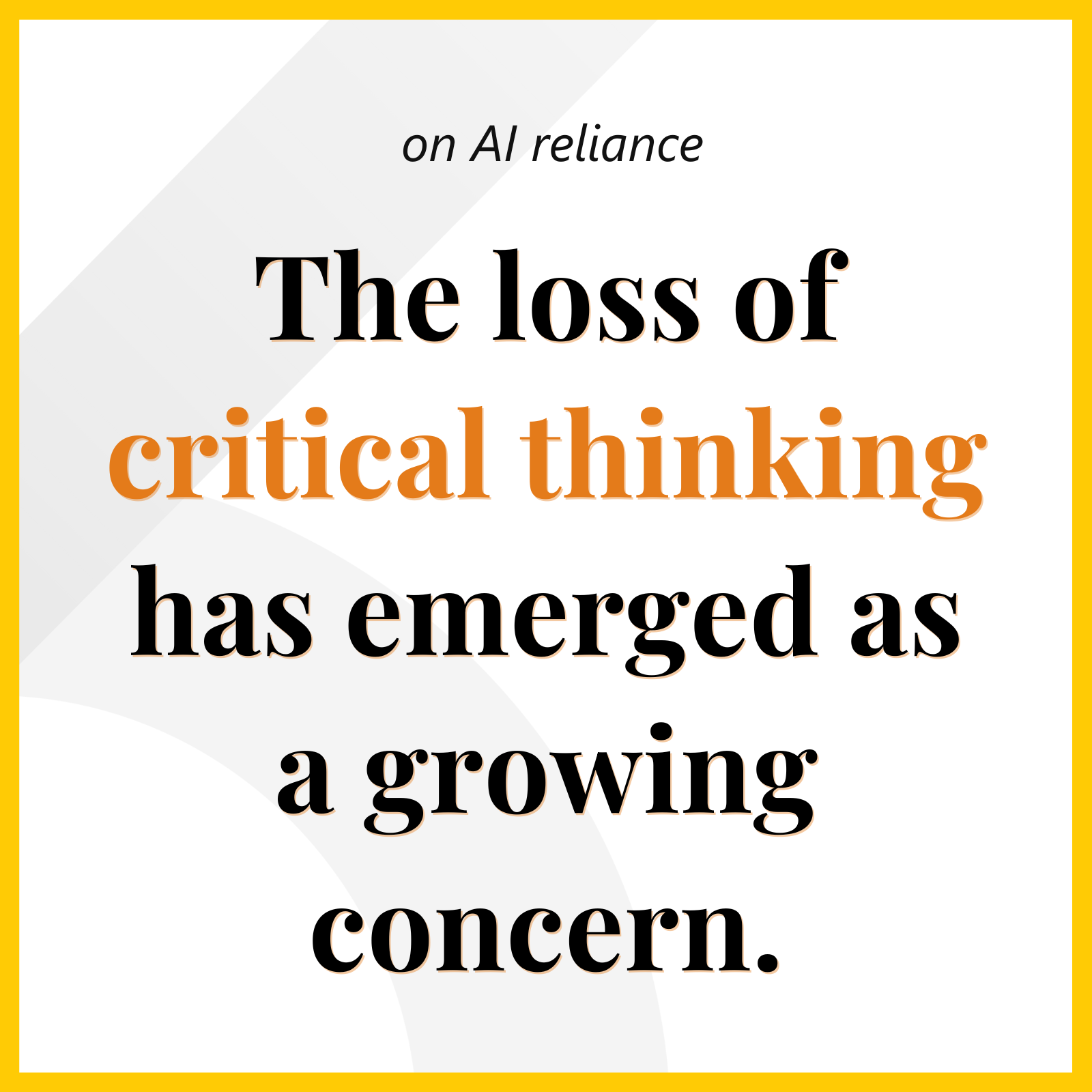
As leaders and professionals increasingly rely on AI, the loss of critical thinking has emerged as a growing concern. Organisations must balance leveraging AI’s capabilities with maintaining and developing the human judgement that remains vital for complex decision-making.
In insurance, AI is already being used to assess claims and damage photos, raising concerns about fairness, accuracy, and accountability.
A memorable moment came during a debate between an AI economist designed by Amplify AI Group and a human AMP economist, where the machine narrowly lost, a reminder that while AI can be powerful, it is not infallible, and human judgement still plays a vital role.
The Cultural Imperative: Investing in People
Building AI capability requires a cultural shift, and many executives acknowledged that foundational literacy around AI remains low across their organisations. Internal investment is needed not just in infrastructure and platforms, but in people. Organisations need to foster hands-on training, build prompt fluency, and develop the competencies required to work effectively alongside AI systems.
An example from Japan’s aged care sector was referenced as a case study in balancing automation with human oversight: robots are integrated into core operations to supplement patient’s need for “human contact” but then needed compliance monitoring of the robot’s conduct by staff. While this model offers operational benefits, it also highlights the challenge of ensuring stringent ethical and compliant practices in increasingly automated environments.
Looking Ahead: Broader Societal Implications
As the discussions drew to a close, attention turned to broader societal implications. Universal income, retraining programmes, and the need for purpose were floated as potential responses to increased AI adoption. There was a shared belief that productivity gains must be distributed fairly, and that leadership must take an active role in shaping not just the technical roadmap, but the human one.
As AI becomes embedded in fund administration, sales processes, and investment strategy, the challenge is not simply to deploy it, but to do so with clarity, ethics, and a deep understanding of its ripple effects on workforce, culture, and society.
Key Takeaways
These roundtables provided valuable insights into how financial services organisations are navigating AI implementation, balancing productivity gains with workforce considerations, and developing governance frameworks that enable innovation while managing risk effectively.
🔹 AI is boosting productivity, but strategy lags: While AI tools are delivering measurable improvements, most organisations remain focused on individual productivity gains. Enterprise-wide transformation is still rare.
🔹 Boards remain cautious: Risk aversion and limited AI literacy are limiting the development of cohesive strategies to unlock competitive advantages.
🔹 Talent implications are significant: As AI enables organisations to achieve more with fewer resources, leaders are grappling with how to structure teams and develop the critical thinking skills needed to complement technology.
🔹 The workforce will look fundamentally different: Organisations are committed to maintaining current staff but anticipate hiring fewer people with different skill profiles going forward.
🔹 Real value comes from transformation, not just tools : Success stories show AI’s power to improve staff satisfaction, retention, and output when thoughtfully implemented.
Why This Matters for Kaizen Recruitment
For Kaizen Recruitment, the insights from these roundtables are not just interesting commentary, they directly inform how we consult with clients and candidates. AI is not only reshaping business models; it is transforming the skills, capabilities, and leadership profiles financial services firms will need in the years ahead.
As AI becomes embedded across functions, organisations will need leaders who can:
- Navigate the balance between automation and human judgement;
- Build AI literacy across their teams;
- Develop governance frameworks that enable innovation while managing risk;
- Reimagine talent strategies for a hybrid human-AI workforces; AND
- Drive cultural changes alongside technological transformation.
Kaizen Recruitment is genuinely grateful to act as a conduit in the market, serving as a trusted external partner to help foster ideas and connections amongst Australia’s leading financial services organisations. The insights gleaned through such events allow us to deeply consult our clients and candidates on key industry trends, challenges, and opportunities.
We look forward to continuing to facilitate these vital industry dialogues and to helping financial services organisations connect with their peers bridging the gap between AI’s potential and real-world impacts.
Get in Touch
Based in Melbourne and Sydney, Kaizen Recruitment specialises in financial services recruitment across funds management, wealth management, superannuation, investment consulting and insurance. If you’d like to discuss candidate career drivers and the current state of the market within the financial services recruitment landscape, feel free to reach out to us with your details below.
Like what you see?
Please feel welcome to join
Kaizen Recruitment’s mailing list
